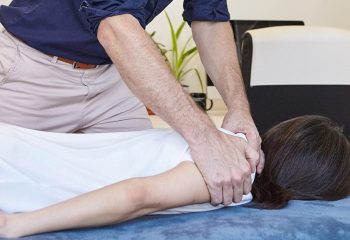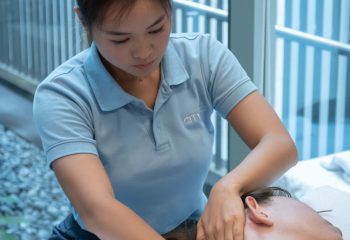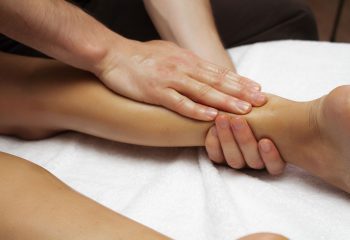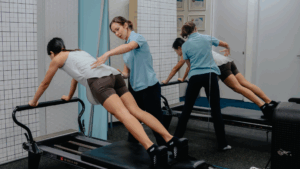Welcome to our clinic’s guide, where we unravel the intricacies of heel sports injuries. Whether you’re a seasoned athlete or just getting started on your fitness journey, understanding the common causes, recognising early signs, and adopting preventative measures is crucial for maintaining optimal heel health.
What are the common causes of heel pain?
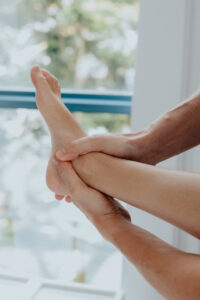
Heel pain can be a complex and multifaceted issue, often arising from various underlying conditions and factors. Understanding these common causes is crucial for individuals seeking relief and effective management of their heel discomfort.
Heel pain from plantar fasciitis
Plantar fasciitis stands out as a prevalent cause of heel pain. The plantar fascia, a thick band of tissue that runs along the bottom of the foot, can become inflamed or strained, leading to discomfort.
Contributing factors: High-impact sports, improper footwear, and overuse of the foot are common culprits that contribute to the development of plantar fasciitis. Athletes who engage in activities involving repetitive stress on the foot, such as running or jumping, are particularly susceptible.
Heel pain from a bruised heel
While the term “bruised heel” may sound minor, it can result in significant pain and inconvenience. This condition occurs when the fat pad under the heel bone becomes bruised due to excessive force or trauma.
Contributing factors: Athletes involved in activities with frequent impact, such as running or activities that involve jumping, may experience a bruised heel. Improper footwear and hard surfaces can exacerbate the risk.
Heel pain from achilles bursitis
The Achilles tendon, a robust structure crucial for movements like running and jumping, can develop inflammation in the bursa sac, leading to Achilles bursitis.
Contributing factors: Repetitive ankle movement, overuse, or sudden increases in physical activity can contribute to the development of Achilles bursitis. Athletes involved in sports that demand frequent and intense ankle motion may be more prone.
Heel pain from Sever’s disease
Sever’s Disease primarily affects adolescents during growth spurts. It involves inflammation of the growth plate in the heel, causing pain and discomfort.
Contributing factors: The rapid growth experienced during adolescence can lead to increased tension on the heel’s growth plate. Sports that involve repetitive impact, such as running and jumping, can exacerbate the condition.
Heel pain from calcaneal stress fracture
For athletes pushing their physical limits, a calcaneal stress fracture can quietly develop. This condition involves tiny cracks in the heel bone due to overuse or repetitive stress.
Contributing factors: Activities that subject the feet to repeated stress, such as long-distance running or intense training, can increase the risk of developing a calcaneal stress fracture.
Heel pain from medial calcaneal nerve entrapment
Nerves in the heel area can become entangled, causing pain and discomfort. Medial calcaneal nerve entrapment occurs when the nerve is compressed.
Contributing factors: Factors such as improper footwear, structural abnormalities in the foot, or activities that put excessive pressure on the heel can contribute to nerve entrapment.
Heel pain from lateral plantar nerve entrapment
Similar to medial calcaneal nerve entrapment, this condition involves the compression of nerves, resulting in pain in the lateral aspect of the heel.
Contributing factors: Activities that involve repetitive pressure on the outer side of the foot, such as certain sports or exercises, can contribute to lateral plantar nerve entrapment.
Heel pain from tarsal tunnel syndrome
Tarsal tunnel syndrome occurs when the tarsal tunnel, housing important nerves, becomes compressed, leading to heel pain.
Contributing Factors: Activities that involve prolonged standing, excessive pronation of the foot, or direct trauma to the ankle can contribute to the development of tarsal tunnel syndrome.
Heel pain from insertional achilles tendonitis
In this condition, the Achilles tendon’s insertion at the heel bone becomes inflamed, causing discomfort.
Contributing factors: Sudden stops and starts during physical activities, as well as repetitive stress on the Achilles tendon, can contribute to the development of insertional Achilles tendonitis.
Heel pain from a heel spur
A heel spur is a bony outgrowth on the underside of the heel bone, often associated with long-term plantar fasciitis.
Contributing factors: Prolonged inflammation of the plantar fascia can lead to the development of heel spurs. While not all heel spurs cause pain, some can contribute to discomfort during sports activities.
Heel pain from calcaneal fracture
In severe cases, a traumatic incident or excessive force can result in a calcaneal fracture, necessitating immediate attention and intervention.
Contributing factors: High-impact injuries, falls from height, or accidents during sports can lead to calcaneal fractures. Such fractures require prompt diagnosis and management.
How to recognise early signs of heel problems?

Now that we’ve identified the potential foes, let’s discuss how to spot the early warning signs of heel issues. Understanding the early signs of heel problems is pivotal for proactive intervention and effective management. Keep a keen eye out for the following subtle cues, as they can be indicative of an underlying issue:
Persistent heel pain
- Significance: Any enduring discomfort or pain in the heel, especially during or after physical activities, can be a red flag.
- What to observe: Note the location, intensity, and frequency of the pain. Consistent discomfort may warrant further investigation.
Tenderness in the heel area
- Significance: Tenderness or sensitivity when touching the heel, either on the bottom or back, can suggest inflammation or injury.
- What to observe: Gently press on different areas of the heel to identify specific points of tenderness.
Swelling around the heel
- Significance: Swelling is often a sign of inflammation, and the heel is no exception. It can be an early indicator of various conditions.
- What to observe: Check for any visible swelling or changes in the size and shape of the heel.
Heel discomfort during activities
- Significance: If routine activities such as walking, running, or even standing become uncomfortable or painful, it could signify an underlying problem.
- What to observe: Pay attention to when the discomfort occurs and whether it subsides with rest.
Changes in gait or walking pattern
- Significance: Heel problems can alter the way you walk to minimize pain. Changes in your gait may indicate an attempt to offload pressure from the affected heel.
- What to observe: Look for any limping, uneven weight distribution, or alterations in your usual walking pattern.
Heel pain in the morning
- Significance: Pain experienced in the heel, particularly in the morning upon waking, is a classic symptom of conditions like plantar fasciitis.
- What to observe: Take note if the pain improves or worsens as you move around throughout the day.
Stiffness in the heel
- Significance: Persistent stiffness, especially after periods of rest, may indicate inflammatory conditions affecting the heel.
- What to observe: Assess the range of motion in your foot and ankle, noting any limitations or stiffness in the heel area.
Changes in skin colour or temperature
- Significance: Unusual changes in skin colour or temperature around the heel could signal circulatory or nerve-related issues.
- What to observe: Check for any redness, warmth, or coolness in the heel area, which may indicate underlying concerns.
If you observe any of these early signs, it’s crucial to take them seriously and seek professional advice promptly.
How can you prevent heel sports injuries?
Heel sports injuries can be disruptive to your active lifestyle, but the good news is that many of them are preventable with the right approach. Adopting proactive measures and making informed choices can significantly reduce the risk of encountering heel pain or injuries during sports activities.
Invest in proper footwear
Your choice of footwear can make or break your foot health, especially when engaging in sports. Ill-fitting or unsupportive shoes can contribute to heel pain and increase the likelihood of injuries.
Tips for choosing the right shoes:
- Ensure proper fit: Shoes should provide adequate room for your toes and offer a snug fit without being too tight.
- Arch support: Consider shoes with appropriate arch support, especially if you have high or low arches.
- Cushioning: Opt for shoes with sufficient cushioning to absorb shock and reduce impact on your heels.
- Activity-specific shoes: Different sports demand different types of movement. Choose shoes designed for the specific demands of your chosen activity.
- Regular shoe checks: Over time, the support and cushioning of shoes can diminish. Regularly assess the condition of your sports shoes and replace them if needed.
Gradual progression in training
Rapidly increasing the intensity or duration of your training sessions can strain your muscles, tendons, and ligaments, making you more susceptible to heel injuries.
Our experienced physiotherapists understand the importance of tailored training programs. By assessing your individual needs and current physical condition, they can design a training regimen that facilitates recovery and minimises the risk of placing excessive pressure on your heels.
Preventive measures:
- Incremental changes: Gradually increase the intensity and duration of your workouts to allow your body to adapt.
- Warm-up routine: Prior to engaging in sports activities, incorporate a dynamic warm-up routine to prepare your muscles and joints for movement.
- Cross-training: Include a variety of exercises in your routine to avoid overloading specific muscles and reduce the risk of overuse injuries.
Proper technique and form
Incorrect techniques and poor form can contribute to excessive stress on your heels and increase the likelihood of injuries.
Our expert physiotherapists are here to provide proper techniques and professional guidance, ensuring that your training sessions are not only effective but also safe. By working with our professionals, you can fine-tune your form, address any biomechanical issues, and prevent heel injuries.
Preventive strategies:
- Professional guidance: Seek guidance from a coach or fitness professional to ensure you are using the correct techniques for your chosen sport.
- Listen to your body: Pay attention to any discomfort or pain during exercises. If something doesn’t feel right, adjust your form or seek advice.
- Regular check-ins: Periodically assess and refine your technique to ensure optimal biomechanics and reduce the risk of injuries.
Adequate rest and recovery
Overtraining and insufficient recovery time can lead to fatigue and increase the risk of heel injuries.
Our dedicated osteopaths specialise in holistic approaches to recovery. Whether you’re dealing with heel injuries or seeking preventive measures, our experts can tailor pain managements to promote optimal healing and enhance overall foot health.
Preventive practices:
- Rest days: Schedule regular rest days in your training routine to allow your body to recover.
- Quality sleep: Ensure you get sufficient and quality sleep to support the body’s natural recovery processes.
- Listen to your body: If you experience persistent fatigue or discomfort, consider adjusting your training intensity and duration.
Maintain a healthy body weight
Excess body weight can put additional strain on your feet and heels, increasing the risk of injuries.
Preventive measures:
- Balanced nutrition: Adopt a well-balanced diet to support overall health and maintain a healthy weight.
- Regular exercise: Incorporate regular physical activity beyond your sports training to support weight management.
Regular foot care
Basic foot care practices can go a long way in preventing heel issues.
Preventive habits:
- Foot hygiene: Keep your feet clean and dry to prevent issues such as fungal infections.
- Trim Toenails: Regularly trim your toenails to prevent ingrown toenails and other related problems.
- Foot Exercises: Incorporate exercises that strengthen the muscles of the foot and ankle to provide additional support.
By adopting these measures, you can actively contribute to the longevity and well-being of your feet, ensuring a smoother and more enjoyable sporting experience. Remember, your feet are your foundation, so treat them well!
Are certain shoes contributing to your heel pain?
Footwear plays a pivotal role in your foot’s well-being. Your choice of shoes can either contribute to or alleviate heel pain. Here are key considerations:
Supportive features in your footwear
- Arch support: Ensure your shoes provide adequate arch support, matching the natural curvature of your foot. This is particularly important for activities that involve repetitive impact.
- Heel cup: A well-designed heel cup helps stabilise the heel and minimises excessive movement during sports activities.
Cushioning quality in your footwear
- Shock absorption: High-quality cushioning, especially in the heel area, helps absorb shock and reduces the impact on your heels, preventing unnecessary strain.
Activity-specific criteria for your footwear
- Choose wisely: Different sports and activities require specific types of shoes. Running shoes, for example, should provide forward motion support, while court shoes need lateral stability. Ensure your shoes align with the demands of your chosen sport.
Regular reassessment
- Replace worn-out shoes: Over time, the cushioning and support in sports shoes can deteriorate. Regularly assess the condition of your shoes and replace them when necessary to maintain optimal foot protection.
Professional fitting of footwear
- Get fitted professionally: Visit a specialised sports shoe store where professionals can assess your foot structure and recommend shoes that suit your individual needs.
By paying attention to your footwear choices and implementing preventive measures, you can take proactive steps towards safeguarding your heels from sports-related injuries. Remember, a little foresight can go a long way in ensuring a pain-free and enjoyable athletic experience.
What are the best stretches for heel injury recovery?
Healing from a heel injury involves more than just rest; it requires a thoughtful approach that includes targeted stretches.
While these stretches provide general guidelines for heel injury recovery, individual responses may vary. If you encounter pain or restrictions, it’s advisable to seek professional guidance with us. Our clinic offers personalised assessments and exercise regimes tailored to your specific needs. Book a consultation with our professionals for a more accurate evaluation and a customised plan to support your healing journey.
Integrating the following stretches into your routine can promote recovery and reduce the risk of future issues:
Calf stretch
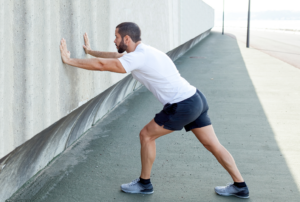
How to do it:
- Stand facing a wall with your hands placed on it for support.
- Step one foot back and keep it straight while bending the front knee.
- Keep your back heel on the ground and feel the stretch in your calf.
- Hold for 15-30 seconds and switch legs.
Benefits:
- Relieves tension in the calf muscles, promoting flexibility and reducing strain on the Achilles tendon.
Plantar fascia stretch
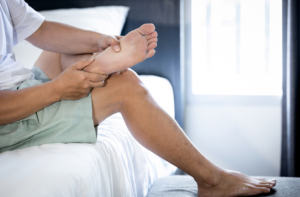
How to do it:
- Sit with one leg crossed over the other.
- Pull your toes back towards your shin using your hand.
- Hold for 15-30 seconds, feeling the stretch along the bottom of your foot.
- Switch legs and repeat.
Benefits:
- Alleviates tension in the plantar fascia, a key player in heel pain.
Towel stretch

How to do it:
- Sit on the floor with your legs stretched out in front of you.
- Loop a towel around the ball of one foot.
- Gently pull the towel towards you while keeping your knee straight.
- Hold for 15-30 seconds, then switch to the other foot.
Benefits:
- Provides a deep stretch to the Achilles tendon and calf muscles, fostering flexibility.
Seated heel stretch
How to do it:
- Sit comfortably with your legs stretched out.
- Cross one ankle over the opposite knee.
- Gently press down on the bent knee, feeling the stretch in your heel and foot.
- Hold for 15-30 seconds and switch to the other side.
Benefits:
- A gentle stretch that targets the entire foot and heel, promoting overall foot flexibility and comfort.
Additional Tips for Effective Stretching
- Consistency is key: Perform these stretches regularly, especially during the recovery phase, to enhance their effectiveness.
- Warm-up first: Always warm up your muscles before stretching to increase blood flow and flexibility.
- Listen to your body: Stretching should feel relieving, not painful. If you experience discomfort, ease off the stretch.
Incorporating these stretches into your daily routine can contribute significantly to heel injury recovery. However, it’s essential to consult with a healthcare professional or a physiotherapist for personalised advice tailored to your specific condition. Remember, a gradual and gentle approach is crucial for a successful recovery journey.
Step into comfort: A healing journey for your heels

Understanding the nuances of heel sports injuries empowers athletes to make informed decisions about their training routines, footwear choices, and overall foot health. By being proactive and attentive to early signs, you can embark on a journey towards a pain-free and active lifestyle. Remember, your heels bear the weight of your athletic pursuits; treat them with the care they deserve. Take the first step towards heel health and book a consultation with our expert physiotherapists and osteopathists today!
FAQs
Can professional athletes avoid heel sports injuries?
Professional athletes are not immune to heel injuries, but their rigorous training routines often involve comprehensive injury prevention strategies. Regular assessments, tailored training programs, and prompt intervention contribute to minimising the risk of heel sports injuries.
What role does footwear play in heel health?
Footwear is more than a fashion statement; it’s a crucial aspect of maintaining heel health. The right shoes provide adequate support, cushioning, and stability, reducing the impact on your heels during sports activities.
Can standing for long periods worsen heel pain?
Prolonged periods of standing can indeed exacerbate heel pain, leading to discomfort and potential injuries. This is especially relevant for individuals whose occupations involve extended periods of standing, such as healthcare professionals, retail workers, and factory workers.
Increased pressure on heels: Standing for long durations places increased pressure on the heels, which can contribute to conditions like plantar fasciitis and heel spurs. The constant load on the feet without adequate breaks can lead to overuse injuries.
Strategies to alleviate discomfort: To mitigate the impact of prolonged standing on heel health, individuals should consider incorporating strategies such as taking short breaks to stretch and change positions, wearing supportive shoes, and using anti-fatigue mats to reduce the strain on the feet.
Proper ergonomics: Employers can also play a role in promoting heel health by implementing ergonomic workplace designs. This includes providing anti-fatigue mats, encouraging regular breaks, and offering supportive footwear options for employees who spend significant time on their feet.
How is a heel injury related to an ankle injury?
The relationship between heel and ankle injuries is often interconnected due to the anatomy and biomechanics of the lower extremities. Understanding this relationship is crucial for a comprehensive approach to injury prevention and management.
Biomechanical connection: The heel bone (calcaneus) is connected to the ankle bone (talus) through various ligaments and tendons. An injury in one area can affect the biomechanics of the other, leading to compensatory movements that may result in further strain and injury.
Chain reaction effect: For example, an untreated ankle sprain can alter walking and running patterns, placing excess stress on the heel. Conversely, a heel injury may lead to changes in gait, potentially impacting the stability of the ankle joint.
Comprehensive pain management: Recognising and addressing the interplay between heel and ankle injuries is essential for a comprehensive plan. This may involve targeted rehabilitation exercises, supportive footwear, and, in some cases, consultation with a healthcare professional for a thorough assessment.
How to manage heel injuries at home?
Not all heel injuries require immediate medical attention, and effective home management strategies can aid in pain relief and promote healing.
Rest and ice: Resting the affected foot and applying ice can help reduce inflammation and alleviate pain. Ice packs, applied for 15-20 minutes at a time, can be beneficial, especially in the early stages of an injury.
Elevation: Elevating the injured foot can assist in minimizing swelling. Keeping the foot elevated, particularly during rest periods, contributes to better circulation and facilitates the body’s natural healing processes.
Stretching exercises: Gentle stretching exercises targeting the calf muscles and the plantar fascia can aid in maintaining flexibility and preventing stiffness. However, it’s essential to perform these exercises with caution and avoid overexertion.
Over-the-counter pain relief: Non-prescription pain relievers, such as ibuprofen or acetaminophen, can be used to manage pain and reduce inflammation. It’s advisable to follow recommended dosage guidelines and consult with a healthcare professional if necessary.
Supportive footwear: Wearing shoes with proper arch support and cushioning can contribute to the healing process. Avoiding shoes with inadequate support or high heels can prevent further strain on the injured heel.
Gradual return to activity: As the heel begins to heal, a gradual return to normal activities is recommended. Rushing back into intense physical activity too soon may exacerbate the injury.
While home management can be effective for certain heel injuries, it’s crucial to seek professional medical advice if the pain persists, worsens, or if there are concerns about the severity of the injury.


